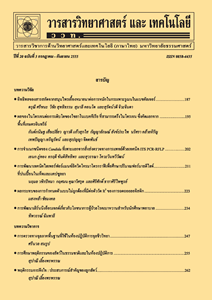คุณภาพของน้ำไผ่
Main Article Content
Abstract
This research aims to investigate physical, chemical and biological characteristics of water from bamboo, and to compare bamboo water quality with groundwater quality standards for consumption, water supply quality standards of metropolitan waterworks authority, and water quality standards in sealed containers. Bamboo water was conducted from 4 species including Dendrocalamus asper, Bambusa burmanica, Bambusa beecheyana and Bambusa striata. In each bamboo species was collected for 4 replicates. The research found that color, odor, turbidity, pH, total hardness, chloride, nitrate, fluoride, iron, copper, zinc, arsenic and coliform bacteria of 4 bamboo water species were passed the criteria complied with 3 types of water quality standards. However, total solids and total dissolved solids of 4 bamboo water species were approximately 3 times greater than those of water quality standards in sealed containers and 2 times higher than those of groundwater quality standards for consumption. Manganese contents of 4 bamboo water species were over those of 3 types of water quality standards. Lead contents of 4 bamboo water species were over those of the water supply quality standards of metropolitan waterworks authority. Escherichia coli was found in all bamboo water species. The bamboo water quality may depend on soil, surrounding environment and preservation.
Article Details
References
[2] Songklatoday, Water from Bamboo can Detoxify Toxins and Relieve Diabetes, Available Sources: https://www.rspg.cmru.ac.th/activity.php?activity=3, December 8, 2015. (in Thai)
[3] Lertsuwanpisan, P., 2006, The analysis of Talaekaew’s underground water quality and packaged drinking water, Rajabhat J. Sci. Human. Soc. Sci. 7(1-2): 26-36. (in Thai)
[4] Sirisingh, K., 2001, Chemistry of Water Wastewater and Analysis, 3rd Ed., Chandrakasem Rajabhat Institute, Bangkok, 370 p. (in Thai)
[5] Seemork, K. and Chaiwong, S., 2014, The application of health education base on health belief model for behavior changing to prevent the fluoride excess in drinking water in Chun district, Phayao province, Naresuan Phayao J. 7(1): 51-64. (in Thai)
[6] Jamjang, K., 2006, Quality analysis of piped water in Kamphangphet Rajabhat University, Golden Teak Human. Soc. Sci. J. 12(1): 85-92. (in Thai)
[7] Supawong, S. and Wachirawongsakorn, P., 2011, Surface water quality in Pibulsongkram Rajabhat University (Talay Kaew), Phitsanulok, Rajabhat J. Sci. Human. Soc. Sci. 12(1): 72-85. (in Thai)
[8] Nimrat, S., Suechamnongkitchakarn, N., Supannapan, K. and Vuthiphandchai, V., 2015, Assessment of physical, pH and microbiological qualities of bottled drinking water produced in Burirum province, Thailand, RMUTP Res. J. 9(2): 32-43. (in Thai)


